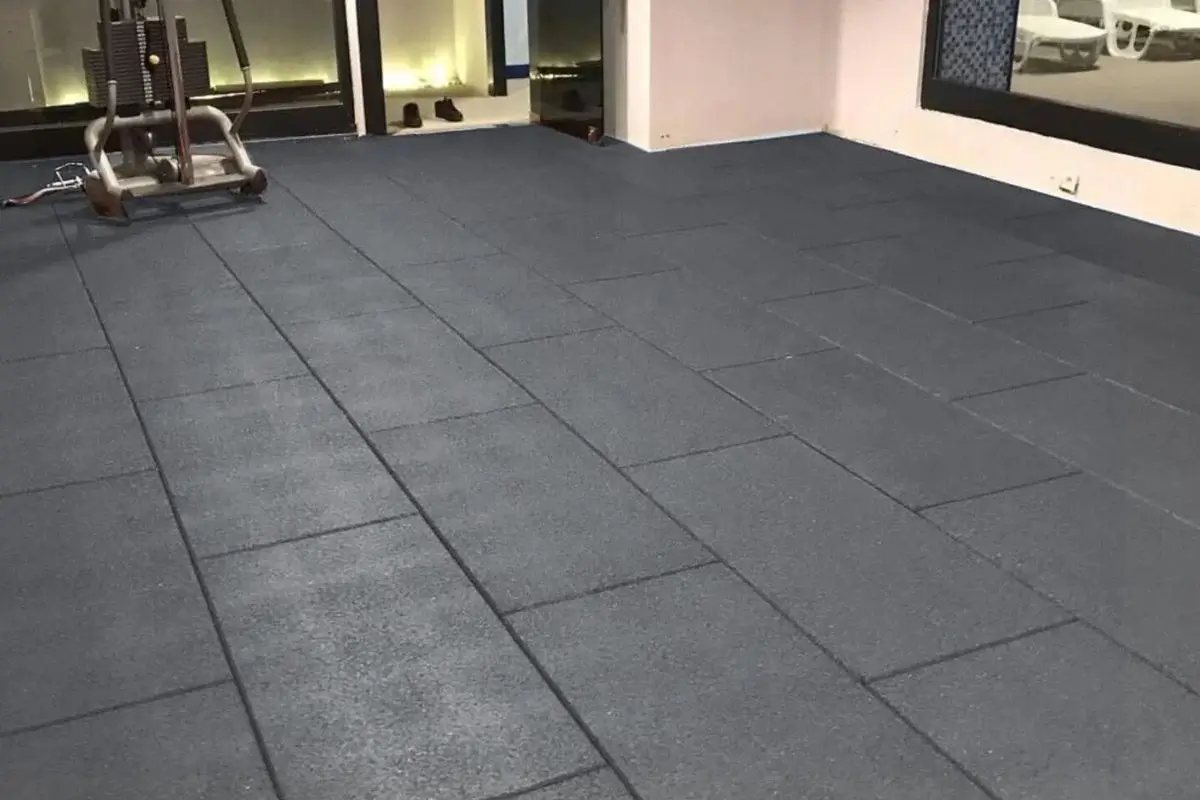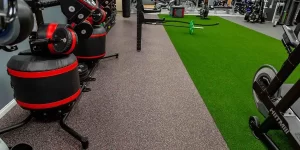Rubber tiles have emerged as a leading choice in flooring solutions, offering a blend of durability, versatility, and aesthetic appeal across various settings. From bustling gyms and vibrant playgrounds to sleek office spaces and cozy homes, rubber tiles have revolutionized the way we approach flooring design and functionality.
In this comprehensive guide, we embark on a journey to explore the world of rubber tiles, delving into their composition, benefits, applications, and installation intricacies. Whether you’re a homeowner embarking on a renovation project, a business owner seeking to enhance workplace safety, or a facility manager aiming to optimize space functionality, this guide equips you with the knowledge and insights needed to make informed decisions about rubber tile flooring.
As we navigate through the nuances of rubber tiles, we unravel their unique features, including their ability to withstand heavy foot traffic, resist wear and tear, and provide a cushioned surface for enhanced comfort and safety. We also delve into the eco-friendly attributes of rubber tiles, shedding light on their sustainable sourcing practices and recyclable materials that align with modern environmental standards.
Definition and Composition of Rubber Tiles
Rubber tiles are specialized flooring materials composed primarily of rubber compounds, designed to provide durability, comfort, and versatility in various indoor and outdoor settings. These tiles are manufactured through a process that involves blending rubber granules or crumbs with binding agents, pigments, and other additives to create a resilient and flexible surface.
The composition of rubber tiles typically includes the following key components:
- Rubber Granules: The primary ingredient in rubber tiles, rubber granules are sourced from recycled rubber materials, such as discarded tires or industrial rubber products. These granules undergo a shredding process to break down the rubber into smaller particles, which are then used as the base material for manufacturing rubber tiles.
- Binding Agents: Binding agents are added to the rubber granules to facilitate cohesion and adhesion during the manufacturing process. Common binding agents include polyurethane, latex, or other synthetic compounds that help bind the rubber particles together and form a stable tile structure.
- Pigments and Colorants: To achieve desired colors and aesthetics, pigments and colorants are incorporated into the rubber mixture during production. This allows for customization and personalization of rubber tiles, enabling designers and homeowners to choose from a wide range of colors, patterns, and designs to complement their interior or exterior spaces.
- Fillers and Additives: Fillers and additives may be included in the rubber tile formulation to enhance specific properties such as strength, flexibility, and resistance to wear and tear. These additives may include reinforcing fibers, UV stabilizers, antimicrobial agents, and flame retardants, depending on the intended application and performance requirements of the rubber tiles.
- The manufacturing process for rubber tiles typically involves mixing the rubber granules, binding agents, pigments, and additives in a controlled environment to ensure uniform distribution and consistency of the mixture. The blended materials are then molded or extruded into tile shapes and subjected to heat and pressure to cure and solidify the rubber composition.
- Once cured, rubber tiles undergo finishing processes such as trimming, cutting, and surface treatments to achieve desired dimensions, textures, and surface profiles. The resulting rubber tiles exhibit excellent resilience, impact absorption, slip resistance, and durability, making them suitable for a wide range of residential, commercial, and industrial applications.
Benefits of Rubber Tiles
Rubber tiles offer a myriad of advantages that make them a preferred choice for various indoor and outdoor applications. Here are some key benefits of using rubber tiles:
- Durability and Longevity: Rubber tiles are renowned for their exceptional durability and resilience, capable of withstanding heavy foot traffic, furniture movement, and everyday wear and tear without deteriorating or losing their structural integrity. Their robust construction ensures long-lasting performance, making them a cost-effective flooring solution in the long run.
- Safety Features: One of the most significant advantages of rubber tiles is their inherent safety features. The cushioned surface of rubber tiles provides excellent impact absorption, reducing the risk of injuries from slips, trips, and falls. Additionally, rubber tiles offer slip-resistant properties, even when wet, making them ideal for environments where safety is paramount, such as playgrounds, gyms, and pool decks.
- Sound Insulation: Rubber tiles act as effective sound insulators, absorbing impact noise and reducing airborne sound transmission between floors and rooms. This makes them an ideal choice for residential and commercial spaces where noise control is essential for maintaining privacy, enhancing acoustics, and creating a comfortable environment for occupants.
- Comfort Underfoot: The cushioned surface of rubber tiles offers superior comfort underfoot, providing a supportive and ergonomic surface for standing, walking, and prolonged periods of activity. This makes rubber tiles particularly suitable for environments where individuals spend extended periods on their feet, such as kitchens, retail spaces, and industrial facilities.
- Low Maintenance: Rubber tiles are remarkably low-maintenance compared to other flooring materials. Their smooth, non-porous surface resists stains, spills, and moisture, making them easy to clean and sanitize with simple household cleaners or mild detergents. With routine sweeping, mopping, and occasional spot cleaning, rubber tiles retain their appearance and functionality for years, saving time and effort in maintenance tasks.
- Eco-Friendly Attributes: Many rubber tiles are manufactured from recycled rubber materials, such as discarded tires and industrial rubber products, making them a sustainable and environmentally friendly flooring option. By repurposing recycled materials, rubber tiles contribute to waste reduction, resource conservation, and the promotion of circular economy principles.
- Versatility and Customization: Rubber tiles come in a variety of colors, textures, and patterns, providing designers and homeowners with endless possibilities to create unique and customized flooring designs. Whether you’re aiming for a sleek and contemporary look or a bold and vibrant statement, rubber tiles offer versatility to match diverse aesthetic preferences and design schemes.
Types of Rubber Tiles
Rubber tiles come in various types, each designed to cater to specific needs and applications. Understanding the different types of rubber tiles can help you choose the most suitable option for your project. Here are some common types of rubber tiles:
- Recycled Rubber Tiles: These tiles are made from recycled rubber materials, such as old tires or post-industrial rubber scraps. Recycled rubber tiles are eco-friendly and sustainable, as they repurpose waste materials that would otherwise end up in landfills. They are durable, resilient, and offer excellent shock absorption, making them ideal for high-traffic areas like gyms, playgrounds, and sports facilities.
- Virgin Rubber Tiles: Virgin rubber tiles are manufactured using new rubber materials without any recycled content. They offer superior quality and consistency compared to recycled rubber tiles. Virgin rubber tiles are known for their durability, resilience, and longevity, making them suitable for commercial and industrial applications where heavy-duty flooring is required.
- Interlocking Rubber Tiles: Interlocking rubber tiles feature a unique interlocking design that allows them to connect seamlessly without the need for adhesive or glue. This makes installation quick and easy, allowing for DIY projects and temporary flooring solutions. Interlocking rubber tiles are versatile and can be used in various settings, including home gyms, playrooms, and trade show floors.
- Glue-Down Rubber Tiles: Glue-down rubber tiles require adhesive or glue to secure them to the subfloor. They offer a more permanent flooring solution compared to interlocking tiles and are suitable for commercial and high-traffic areas where stability and durability are paramount. Glue-down rubber tiles provide a seamless and professional-looking finish, making them ideal for retail spaces, offices, and healthcare facilities.
- Textured Rubber Tiles: Textured rubber tiles feature embossed or textured surfaces that enhance slip resistance and traction. They are commonly used in wet and slippery areas such as pool decks, locker rooms, and shower areas, where safety is a primary concern. Textured rubber tiles provide added grip underfoot, reducing the risk of slips and falls in potentially hazardous environments.
- Colorful Rubber Tiles: Colorful rubber tiles come in a wide range of vibrant colors and patterns, allowing for creative and customized flooring designs. They are popular choices for children’s play areas, daycare centers, and schools, where bright and cheerful aesthetics are desired. Colorful rubber tiles can also be used to delineate spaces or create visual interest in commercial and retail settings.
- Outdoor Rubber Tiles: Outdoor rubber tiles are specifically designed to withstand harsh weather conditions and outdoor elements. They are UV-resistant, fade-resistant, and waterproof, making them ideal for patios, decks, and outdoor recreational areas. Outdoor rubber tiles offer durability and safety while enhancing the aesthetic appeal of outdoor spaces.
Maintenance and Cleaning Guidelines
Maintaining and cleaning rubber tiles is essential to preserve their appearance, functionality, and longevity. Here are some practical guidelines to help you keep your rubber tiles in top condition:
- Regular Sweeping and Vacuuming: Remove loose dirt, dust, and debris from the surface of the rubber tiles using a broom or vacuum cleaner with a soft brush attachment. Regular sweeping or vacuuming prevents dirt buildup and maintains the appearance of the flooring.
- Mopping with Mild Detergent: For routine cleaning, mop the rubber tiles with a solution of mild detergent and warm water. Avoid using harsh chemicals or abrasive cleaners, as they may damage the surface of the tiles. Rinse the tiles thoroughly with clean water to remove any soap residue.
- Spot Cleaning Spills and Stains: Promptly clean up spills and stains on the rubber tiles to prevent them from setting and becoming difficult to remove. Use a damp cloth or sponge with mild detergent to spot clean the affected areas. For stubborn stains, gently scrub the surface with a soft-bristled brush.
- Avoid Standing Water: Prevent standing water from accumulating on the surface of the rubber tiles, as it can seep into the seams and edges, causing damage and promoting mold and mildew growth. Wipe up spills and excess moisture immediately to maintain a dry and clean environment.
- Deep Cleaning Periodically: Perform deep cleaning of the rubber tiles periodically to remove embedded dirt, grease, and grime. Use a commercial rubber floor cleaner or a solution of vinegar and water to deep clean the tiles. Follow the manufacturer’s instructions for dilution ratios and application methods.
- Disinfection as Needed: In environments where hygiene is a concern, such as healthcare facilities or gyms, disinfect the rubber tiles regularly to kill germs and bacteria. Use a disinfectant solution recommended for rubber flooring and follow the manufacturer’s instructions for proper application and contact time.
- Avoid Abrasive Cleaning Tools: Avoid using abrasive cleaning tools such as steel wool pads or abrasive scrub brushes, as they can scratch or damage the surface of the rubber tiles. Use soft cloths, sponges, or non-abrasive scrubbing pads for gentle cleaning and maintenance.
- Protective Measures: Place mats or rugs at entryways and high-traffic areas to trap dirt and moisture before it reaches the rubber tiles. Use furniture pads or coasters to prevent scratching and indentation from heavy furniture or equipment.
- Regular Inspection: Inspect the rubber tiles periodically for signs of wear, damage, or deterioration. Repair or replace any damaged or worn tiles promptly to prevent further damage and maintain the integrity of the flooring system
Conclusion
In conclusion, maintaining and cleaning rubber tiles is crucial for preserving their appearance, functionality, and longevity. By following the guidelines outlined above, you can ensure that your rubber tiles remain in top condition, providing a clean, safe, and hygienic environment for occupants.










